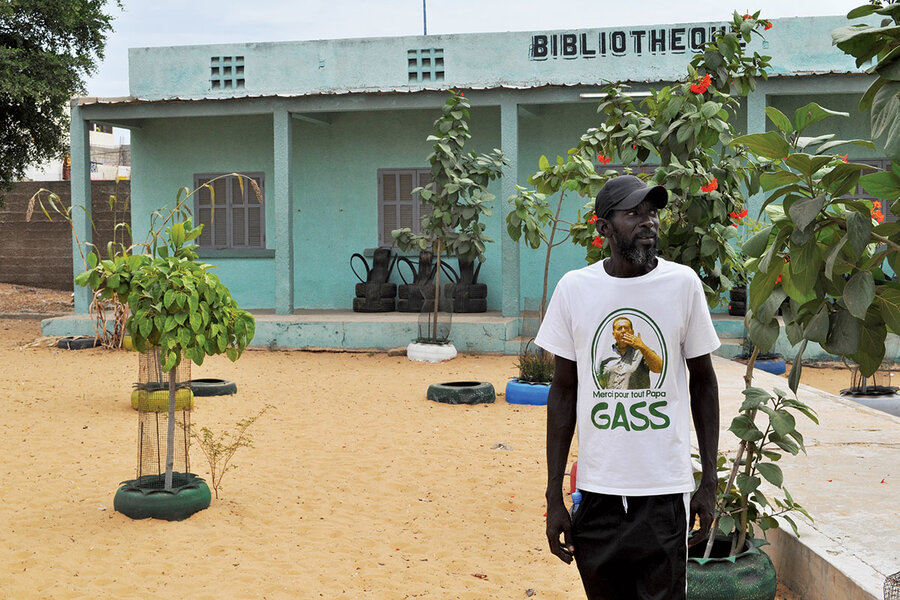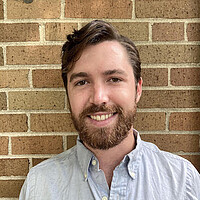Growing shade: An epic quest to plant a tree for every home in Senegal
Loading...
| Guédiawaye, Senegal
He’s known around Senegal as l’homme plastique, or the plastic man, a nod to the homemade ghillie suit covered in plastic bags he dons at protests and when addressing the media. But it’s Modou Fall’s “million trees, million tires” project that is transforming this densely packed, oft-neglected suburb of Dakar, Senegal, where he lives.
Tree-planting projects have gained new currency around the world in recent years. Once prized as either ornamentation or commodity, trees are now sought for their environmental and social benefits as well. For Mr. Fall, they are a gift of community.
Why We Wrote This
Tree-planting projects tend to come with big promises that prove hard to keep. In Senegal, one activist has found a recipe for success by taking it one tree at a time.
Not everyone has the means to invest in big development projects. But one thing everyone can do “is to plant a tree,” he says.
Mr. Fall and his army of volunteers aim to plant one tree for every home in Senegal, using recycled tires as planters to help deter rooting animals. It’s a lofty goal, but his neighbors are already reaping the rewards.
“Without this tree, it was hot. It was difficult,” says Arona Faye, sitting outside his home in a chair made of tires. “The whole neighborhood has trees [now]. We’re thanking God.”
With the turn of a corner, the scorched, sandy roads of this concrete jungle suddenly give way to cool, shaded streets. Lining doorways for a handful of blocks are trees planted just last year, already reaching toward second-story windows. Younger sprigs poke their stems out of planters made from refashioned tires.
Modou Fall stops to inspect the trees on his way back from the beach, where he was shooting a video about ocean pollution with the local news site. He’s a well-known environmental activist, dubbed l’homme plastique, or the plastic man, a nod to the homemade ghillie suit covered in plastic bags he dons at protests and when addressing the media. But it’s his “million trees, million tires” project that is transforming this densely packed, oft-neglected suburb of Dakar, Senegal, where he lives.
Tree-planting projects have gained new currency around the world in recent years. Once prized as either ornamentation or commodity, trees are now sought for their environmental and social benefits as well. For Mr. Fall, they are a gift of community.
Why We Wrote This
Tree-planting projects tend to come with big promises that prove hard to keep. In Senegal, one activist has found a recipe for success by taking it one tree at a time.
“If you have the means to build a mosque, you do that. If you don’t, fine. If you have the means to build a hospital for people to treat themselves at, you do that. If you don’t have [the means], fine,” he says later from his home, surrounded by furniture made from upcycled tires. But one thing everyone can do “is to plant a tree,” he says.
Mr. Fall and his army of volunteers aim to plant one tree for every home in Senegal, using recycled tires as planters to help deter rooting animals. It’s a lofty goal, but the resources are abundant.
Throughout the West African nation, tires lie strewn about roads, canals, and beaches, with few prospects for reuse or recycling. Seeds too are plentiful, as donations and private grants have yielded everything from local lime and mango trees, to shady and nutritious gmelina and moringa trees. The project got off the ground in 2020, and then, like everything else in the world, ran into a wall when the pandemic hit. But 8,500 seeds and tires were given out before the pandemic, and planting has picked up again in recent months.
Working with local authorities and neighbors who are interested in hosting trees or, in one case, at a local school, Mr. Fall provides the tires, seeds, and wire fencing. “I only ask that you provide the water,” he says.
“Trees breathe, people breathe”
As in many growing cities, expansion in neighborhoods of Dakar often comes at the expense of green space, Mr. Fall says. These areas are noticeably warmer than older neighborhoods where decades-old trees line streets. But restoring shade can draw people outside, to socialize and find respite in a city where the heat index can soar past 100 degrees Fahrenheit during hotter months. What’s more, trees are carbon banks in a world hoping to curb emissions. And Mr. Fall’s neighbors speak highly of local trees’ nutritional and medicinal qualities as well – in the local Wolof language, “tree” and “medicine” are the same word.
“This tree is good,” for both animals and humans, says Arona Faye, sitting outside his home in a chair made of tires. His son learned to construct tire planters and furniture from Mr. Fall – who learned how to do it via YouTube – and now sells them. Outside Mr. Faye’s house, a stack of tires awaits transformation into chairs and tables. But the shade cast by one of Mr. Fall’s trees is the real star of the home. “Without this tree, it was hot. It was difficult,” Mr. Faye says. “The whole neighborhood has trees [now]. We’re thanking God.”
His neighbor Aminata Seck is eagerly awaiting her own slice of the shade. “When we leave the house, it’s hot – but we will have a place to sit,” says Ms. Seck, gesturing to the tires outside her home hosting maturing seedlings. “If you want to breathe clean air, you need to have trees. Trees breathe, people breathe.”
Not just any tree
The benefits of planting trees may be more universally understood, but the jury is still out on how best to restore tree cover. Many tree-planting campaigns around the world face a host of potential problems – including a lack of biodiversity if only one species is planted, unreliable seed supplies, nonnative species faltering in unfamiliar climates, and a lack of buy-in from locals who are needed to maintain the trees. Tree planting often fails to turn into “tree growing,” says Bernadette Arakwiye, a researcher with the nonprofit World Resources Institute’s forest program. But, she adds, those challenges are all surmountable with the right planning.
“A lot of successful stakeholders in this space are the ones that have long-term [plans] engaging local communities, really making sure that whatever trees that end up being planted and grown are trees that those communities want,” says Dr. Arakwiye, who is based in Kigali, Rwanda. “And usually that is also complemented by the science, because it’s not [only] about the species people want; they should be species that grow there. So those two things have to happen at the same time.”
Mr. Fall is familiar with tree-planting pitfalls. His trees sometimes die from lack of water from forgetful caretakers or are torn up by rambunctious toddlers. The tires offer some degree of protection for young trees that might look tasty to hungry animals. (As trees outgrow their planters 10-15 years from now, the tires can be removed.) But errant cows and sheep do sometimes make a snack out of recent seedlings.
At a primary school, Mr. Fall and local officials tussled with residents who wanted the courtyard to remain tree-free, so they could use it for pickup soccer games. Eventually, school authorities determined that trees were a better fit for the space – about 75 planted by Mr. Fall are prospering now, with the trees providing shade and lemons, and chairs made of tires providing a place to rest outside the library. Mr. Fall hopes to incorporate an environmental educational component into the curriculum so students can learn to plant and tend to their own trees one day.
It’s all part of his effort to grow a community of stewards in a city where physical and economic growth has often outpaced environmental concerns.
A mindset takes hold
“There isn’t a single place around here that does recycling, you understand?” says Ndiombane Diop, who constructs furniture to sell and planters to give away at Mr. Fall’s workshop. “But tires are useful.”
In recognition of that utility, local repair shops have started to donate spare tires that are no longer roadworthy and might have languished on beaches or by the side of the road. “I’m going to come get your tires!” Mr. Fall shouts at one shop owner from a taxi window as he zips through Guédiawaye. The owner laughs and nods. A few blocks later, the taxi passes another auto shop; this one hosts one of Mr. Fall’s chairs and planters on its patio.
“I want my neighborhood to be a neighborhood of reference – a neighborhood without sun,” he says. He might be exaggerating a bit about that last part. But on a hot day earlier this fall, with temperatures climbing into the 90s, it doesn’t sound so bad.










